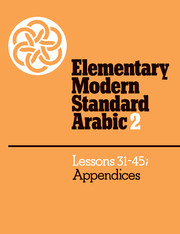Book contents
- Frontmatter
- INTRODUCTION
- Abbreviations and Symbols
- Contents
- LESSON 31
- LESSON 32
- LESSON 33
- LESSON 34
- LESSON 35
- LESSON 36
- LESSON 37
- LESSON 38
- LESSON 39
- LESSON 40
- LESSON 41
- LESSON 42
- LESSON 43
- LESSON 44
- LESSON 45
- APPENDIX I VERB TABLES
- APPENDIX II DAYS AND MONTHS
- APPENDIX III THE ARAB STATES
- APPENDIX IV ADJECTIVES BY LESSON
- APPENDIX V PARTICLES
- APPENDIX VI VERBS
- ENGLISH-ARABIC GLOSSARY
- ARABIC-ENGLISH GLOSSARY
- SUBJECT INDEX
INTRODUCTION
Published online by Cambridge University Press: 05 June 2012
- Frontmatter
- INTRODUCTION
- Abbreviations and Symbols
- Contents
- LESSON 31
- LESSON 32
- LESSON 33
- LESSON 34
- LESSON 35
- LESSON 36
- LESSON 37
- LESSON 38
- LESSON 39
- LESSON 40
- LESSON 41
- LESSON 42
- LESSON 43
- LESSON 44
- LESSON 45
- APPENDIX I VERB TABLES
- APPENDIX II DAYS AND MONTHS
- APPENDIX III THE ARAB STATES
- APPENDIX IV ADJECTIVES BY LESSON
- APPENDIX V PARTICLES
- APPENDIX VI VERBS
- ENGLISH-ARABIC GLOSSARY
- ARABIC-ENGLISH GLOSSARY
- SUBJECT INDEX
Summary
Part Two is a continuation of Part One; it begins the transition to the intermediate level of Arabic. Lessons 31–40 anticipate the format of Modern Standard Arabic Intermediate Level in that the new vocabulary of each lesson is introduced in Preparatory Sentences which present the new item in a meaningful context; for the most part the Preparatory Sentences themselves constitute a connected narrative or discourse. Following the sentence the new item is given in its “citation” or dictionary form: (1) for nouns and adjectives, the nominative singular; the plural, preceded by a dash (any alternative plurals are separated by commas); and any preposition that characteristically occurs with this word in this meaning and (2) for verbs: perfect tense, third masculine singular; the imperfect stem vowel for Form I verbs; the verbal noun, preceded by a comma; and any prepositions that characteristically go with this verb in this meaning. The vocabulary items in the Preparatory Sentences are generally all found in the Basic Text of that lesson; the Additional Vocabulary, on the other hand, are not in the Basic Text but are found later in this and in succeeding lessons and must be mastered. Passive vocabulary (words necessary to a particular passage but not necessarily repeated or drilled elsewhere, and which the student is not required to master) is enclosed in brackets [ ]. In the Basic Text and other passages, passive vocabulary is underlined and translated in the margin.
- Type
- Chapter
- Information
- Elementary Modern Standard Arabic , pp. iiiPublisher: Cambridge University PressPrint publication year: 1983

